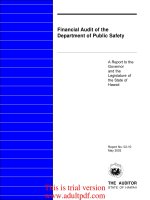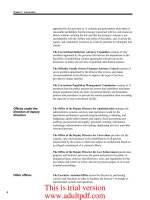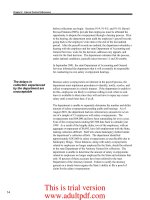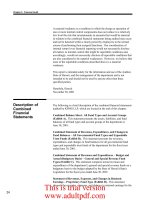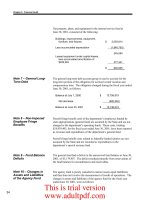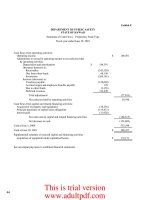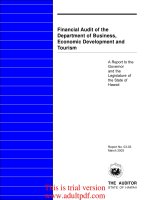Financial Audit of the Department of Public Safety A Report to the Governor and the Legislature _part1 pot
Bạn đang xem bản rút gọn của tài liệu. Xem và tải ngay bản đầy đủ của tài liệu tại đây (343.5 KB, 10 trang )
Financial Audit of the
Department of Public Safety
A Report to the
Governor
and the
Legislature of
the State of
Hawaii
THE AUDITOR
STATE OF HAWAII
Report No. 02-10
May 2002
This is trial version
www.adultpdf.com
Office of the Auditor
The missions of the Office of the Auditor are assigned by the Hawaii State Constitution
(Article VII, Section 10). The primary mission is to conduct post audits of the transactions,
accounts, programs, and performance of public agencies. A supplemental mission is to
conduct such other investigations and prepare such additional reports as may be directed by
the Legislature.
Under its assigned missions, the office conducts the following types of examinations:
1. Financial audits attest to the fairness of the financial statements of agencies. They
examine the adequacy of the financial records and accounting and internal controls, and
they determine the legality and propriety of expenditures.
2. Management audits, which are also referred to as performance audits, examine the
effectiveness of programs or the efficiency of agencies or both. These audits are also
called program audits, when they focus on whether programs are attaining the objectives
and results expected of them, and operations audits, when they examine how well
agencies are organized and managed and how efficiently they acquire and utilize
resources.
3. Sunset evaluations evaluate new professional and occupational licensing programs to
determine whether the programs should be terminated, continued, or modified. These
evaluations are conducted in accordance with criteria established by statute.
4. Sunrise analyses are similar to sunset evaluations, but they apply to proposed rather than
existing regulatory programs. Before a new professional and occupational licensing
program can be enacted, the statutes require that the measure be analyzed by the Office
of the Auditor as to its probable effects.
5. Health insurance analyses examine bills that propose to mandate certain health
insurance benefits. Such bills cannot be enacted unless they are referred to the Office of
the Auditor for an assessment of the social and financial impact of the proposed
measure.
6. Analyses of proposed special funds and existing trust and revolving funds determine if
proposals to establish these funds are existing funds meet legislative criteria.
7. Procurement compliance audits and other procurement-related monitoring assist the
Legislature in overseeing government procurement practices.
8. Fiscal accountability reports analyze expenditures by the state Department of Education
in various areas.
9. Special studies respond to requests from both houses of the Legislature. The studies
usually address specific problems for which the Legislature is seeking solutions.
Hawaii’s laws provide the Auditor with broad powers to examine all books, records, files,
papers, and documents and all financial affairs of every agency. The Auditor also has the
authority to summon persons to produce records and to question persons under oath.
However, the Office of the Auditor exercises no control function, and its authority is limited to
reviewing, evaluating, and reporting on its findings and recommendations to the Legislature and
the Governor.
THE AUDITOR
STATE OF HAWAII
Kekuanao‘a Building
465 S. King Street, Room 500
Honolulu, Hawaii 96813
This is trial version
www.adultpdf.com
The Auditor State of Hawaii
OVERVIEW
Financial Audit of the Department of Public Safety
Report No. 02-10, May 2002
Summary
4
The Office of the Auditor and the certified public accounting firm of KPMG LLP
conducted a financial audit of the Department of Public Safety, State of Hawaii for
the fiscal year July 1, 2000 to June 30, 2001. The audit examined the financial
records and transactions of the department; reviewed the related systems of
accounting and internal controls; and tested transactions, systems, and procedures
for compliance with laws and regulations.
We found deficiencies in the financial accounting and internal control practices of
the department. The department continues to experience unusual patterns of sick
leave and overtime costs are significant. During the fiscal year under audit, an
average of 27 sick leave days was taken for all uniformed staff. This is
significantly higher than the average of ten days for all state employees.
During FY2000-01, the facilities incurred about $7 million in overtime costs,
nearly 13 percent of facility salaries and wages. In our sample of 25 ACOs and
medical and food service staff with highly unusual overtime compensation levels,
approximately 40 percent of their total compensation was related to overtime or
about $22,000 of overtime pay per employee. Some employees were paid more
for overtime than for their regular salaries and wages.
The department continues to maintain a significant outstanding balance of salary
overpayments—$1.8 million, of which the department estimates that approximately
$598,000 will be uncollectible. The process of collecting salary overpayments
typically takes between 11 and 20 months under optimal conditions.
The department is still unable to reconcile inmate trust account balances to bank
balances. For example, the inmate trust bank account at the Women’s Community
Correctional Center has not been reconciled since 1999. The staff responsible for
this task are not held accountable and the lack of proper reconciliation procedures
makes it difficult to determine whether the unreconciled differences were caused
by accounting errors or possible misappropriation of funds.
Furthermore, the department has not reduced the number of inmate accounts
related to released or paroled inmates. On June 30, 2001, there were 2,554 inactive
inmate accounts for paroled or released inmates totaling approximately $107,800.
The department fails to withhold inmate funds for victim restitution and child
support despite the fact that the inmates have available funds.
Finally, we found that the department is unable to document the reported value of
its fixed assets of $134 million. Nor is it able to reconcile the amount of fixed assets
reported in the internal service fund on June 30, 2001 to its Annual Inventory
This is trial version
www.adultpdf.com
Report No. 02-10 May 2002
Marion M. Higa Office of the Auditor
State Auditor 465 South King Street, Room 500
State of Hawaii Honolulu, Hawaii 96813
(808) 587-0800
FAX (808) 587-0830
Report of Property. The unreconciled difference is approximately $473,000. This
is of concern since the department, in the fiscal year ending on June 30, 2002, will
be required by governmental accounting standards to present financial statements
similar to business type organizations, including the computation of depreciation
expense for its fixed assets. Failure to comply with this requirement will have a
serious impact on the accuracy of the department’s financial statements in future
audits.
We recommend that the department work with the bargaining units to implement
a more stringent policy for determining unusual patterns of sick leave abuse
subject to investigation. At a minimum, the policy should restrict ACOs from
being called in for overtime if they called in sick within the prior seven days. The
department should also establish more specific criteria for determining when
overtime is necessary, identify watches consistently incurring unusual overtime
costs, and require that overtime for those watches be authorized by the chief of
security or the warden prior to calling in ACOs to work overtime. The department
should also prepare exception reports identifying employees and watches with
unusually high sick leave pay and use this information to monitor and investigate
sick leave abuse and minimize overtime costs, and monitor overtime costs by
individual to ensure that allocation of overtime is equitable.
The department should perform required audits of salary overpayments in a timely
manner and in compliance with laws and regulations. It should reduce the backlog
of pending audits by setting monthly departmental goals for the number of audits
and hearings to be performed. Also, the department should develop a program for
the eventual responsibility of conducting salary overpayment hearings. The
department should also consider contracting out the salary collection process on
a contingency basis.
The department should immediately reconcile inmate trust accounts to bank
balances. Inactive inmate accounts outstanding over 180 days should be identified
and remitted to the Department of Budget and Finance. The department should
also implement a system whereby all restitution and child support are identified
and remitted to the proper agencies on a quarterly or semi-annual basis.
The department should document the reported cost basis of all fixed assets and
should reconcile the Annual Inventory Report of Property to the financial
statements.
The department generally agrees with most of our findings and recommendations;
however, it commented that it believes some of the findings and conclusions “do
not accurately reflect a full understanding of the issues.”
Recommendations
and Response
This is trial version
www.adultpdf.com
Financial Audit of the
Department of Public Safety
Report No. 02-10
May 2002
A Report to the
Governor
and the
Legislature of
the State of
Hawaii
Conducted by
The Auditor
State of Hawaii
and
KPMG LLP
THE AUDITOR
STATE OF HAWAII
Submitted by
This is trial version
www.adultpdf.com
v
Table of Contents
Chapter 1 Introduction
Background 1
Organization 2
Objectives of the Audit 5
Scope and Methodology 5
Chapter 2 Internal Control Deficiencies
Summary of Findings 7
Significant Overtime and Unusual Sick Leave Usage
Continue 7
Recommendations 12
$1.8 Million in Staff Overpayments Remain
Uncollected 13
Recommendations 15
The Department Is Not Fulfilling Its Fiduciary
Responsibilities to the Inmates and the Victims and
Families of the Inmates 15
Recommendations 19
The Department Is Unable to Substantiate the Cost
Basis of Its General Fixed Assets and Is Unable
to Reconcile the Fixed Assets Reported by the
Internal Service Fund to the Annual Physical
Inventory of Property 20
Recommendation 20
Chapter 3 Financial Audit
Summary of Findings 21
Independent Auditors’ Report 21
Report on Compliance and on Internal Control Over
Financial Reporting Based on an Audit of Financial
Statements Performed in Accordance with
Government Auditing Standards 23
Description of Combined Financial Statements 24
Notes to Combined Financial Statements 25
Notes 45
This is trial version
www.adultpdf.com
vi
Response of the Affected Agency 47
List of Exhibits
Exhibit 1.1 Hawaii's Correctional Facilities and Community
Correctional Centers 2
Exhibit 1.2 Organizational Structure of the Department of Public
Safety 3
Exhibit 2.1 Detail of Base Compensation and Overtime
Compensation for Three Employees at the Halawa
Correctional Facility 11
Exhibit 2.2 ITA System Balances, Bank Reconciliation
Balances, and Differences Between the Balances
for Each Facility as of June 30, 2001 16
Exhibit A Combined Balance Sheet - All Fund Types and
Account Groups, June 30, 2001 40
Exhibit B Combined Statement of Revenues, Expenditures,
and Changes in Fund Balances - All
Governmental Fund Types and Expendable
Trust Funds, Fiscal year ended June 30, 2001 41
Exhibit C Combined Statement of Revenues and
Expenditures - Budget and Actual
(Budgetary Basis) General and Special
Revenue Fund Types, Fiscal year ended
June 30, 2001 42
Exhibit D Statement of Revenues, Expenses, and Changes in
Retained Earnings - Proprietary Fund Type, Fiscal
year ended June 30, 2001 43
Exhibit E Statement of Cash Flows - Proprietary Fund Type,
Fiscal year ended June 30, 2001 44
This is trial version
www.adultpdf.com
1
Chapter 1: Introduction
Chapter 1
Introduction
This is a report of our financial audit of the Department of Public Safety,
State of Hawaii (department). The audit was conducted by the Office of
the Auditor and the independent certified public accounting firm of
KPMG LLP. The audit was conducted pursuant to Section 23-4, Hawaii
Revised Statutes (HRS), which requires the State Auditor to conduct
postaudits of the transactions, accounts, programs, and performance of
all departments, offices, and agencies of the State of Hawaii (State) and
its political subdivisions.
The department is responsible for: providing for the custody, care, and
assistance in the rehabilitation of all persons incarcerated by the courts
or otherwise subject to confinement based on commitment or an alleged
commitment of a criminal offense; guarding State property and facilities;
preserving peace and protecting the public in designated areas; enforcing
specified laws, rules, and regulations for the prevention of crime; and
serving process papers in civil and criminal proceedings. Section 26-
14.6, HRS, further describes the department’s responsibilities:
The department shall be responsible for the formulation and
implementation of state policies and objectives for correctional, security,
law enforcement, and public safety programs and functions; the
administration and maintenance of all public or private correctional
facilities and services; the service of process papers; and the security of
state buildings.
The department manages the State’s three correctional facilities and five
community correctional centers. Exhibit 1.1 identifies the location and
number of inmates in the State’s correctional facilities and community
correctional centers.
Additionally, the department contracts with the Correctional Corporation
of America and Dominion Management to house Hawaii inmates in
Oklahoma and Arizona to alleviate prison overcrowding. During FY
2000-01, the department spent approximately $20 million to house about
1,200 inmates in these out-of-state facilities.
The department is funded primarily with state moneys. During FY2000-
01, the department received approximately $154 million or about 94
percent of total funding from the State through appropriations and non-
Background
Departmental funding
This is trial version
www.adultpdf.com
2
Chapter 1: Introduction
imposed employee fringe benefits. The remainder of the department’s
funding is from federal grants and revenues of the Correctional
Industries Program.
The director oversees, directs, and coordinates the plans, programs, and
operations of the department to provide for the safety of people, both
residents and visitors, from crimes against people and property. The
director is supported by five administratively attached bodies; three
deputy directors who are responsible for the offices for administration,
corrections, and law enforcement; and five other offices. Exhibit 1.2
displays the department’s organizational structure. The primary
responsibilities of these units follows.
The Crime Victims Compensation Commission consists of three
members appointed by the governor to mitigate the suffering and losses
of victims and the dependents of deceased victims of certain crimes by
compensating them for medical expenses, loss of earning power, pain
and suffering, and other financial losses that were the direct result of
injury or death of the victim; and to compensate private citizens for
personal injury or property damage suffered in the prevention of a crime
or the apprehension of a criminal.
The Hawaii Paroling Authority consists of three members nominated
by a panel composed of members from the public and private sectors and
Exhibit 1.1
Hawaii's Correctional Facilities and Community
Correctional Centers
Inmate
Island Facility Count*
Oahu Halawa Correctional Facility 1,274
Waiawa Correctional Facility 331
Oahu Community Correctional Center 1,142
Women's Community Correctional Center 286
Hawaii Kulani Correctional Facility 167
Hawaii Community Correctional Center 238
Maui Maui Community Correctional Center 338
Kauai Kauai Community Correctional Center 125
Total 3,901
* Inmate count as of June 30, 2001.
Organization
Administratively
attached bodies
This is trial version
www.adultpdf.com
3
Chapter 1: Introduction
OfficeoftheDirector
Exhibit1.2
OrganizationalStructureoftheDepartmentofPublicSafety
CrimeVictims
Compensation
Commission*
HawaiiParoling
Authority*
CorrectionalIndustries
AdvisoryCommittee*
OffenderFamily
ServiceProgram
AdvisoryCouncil*
CorrectionsPopulation
Management
Commission*
ExecutiveAssistant
Office
PublicAffairsOffice InternalAffairsOffice
Inspectionsand
InvestigationsOffice
CivilRights
ComplianceOffice
OfficeoftheDeputy
Directorfor
Administration
OfficeoftheDeputy
Directorfor
Corrections
OfficeoftheDeputy
DirectorforLaw
Enforcement
FiscalOffice
Administrative
ServicesOffice
TrainingandStaff
DevelopmentOffice
Personnel
ManagementOffice
ClassificationOffice
ProgramCoordination
Office
IntakeServiceCenters
Division
Community
CorrectionalCenters
Division
CorrectionalFacilities
Division
HealthCareDivision
CorrectionsProgram
ServicesDivision
CorrectionalIndustries
Division
ProtectiveServices
Division
ExecutiveProtection
Section
NarcoticsEnforcement
Division
SheriffDivision
*Administrativelyattachedtothedepartment.
This is trial version
www.adultpdf.com


